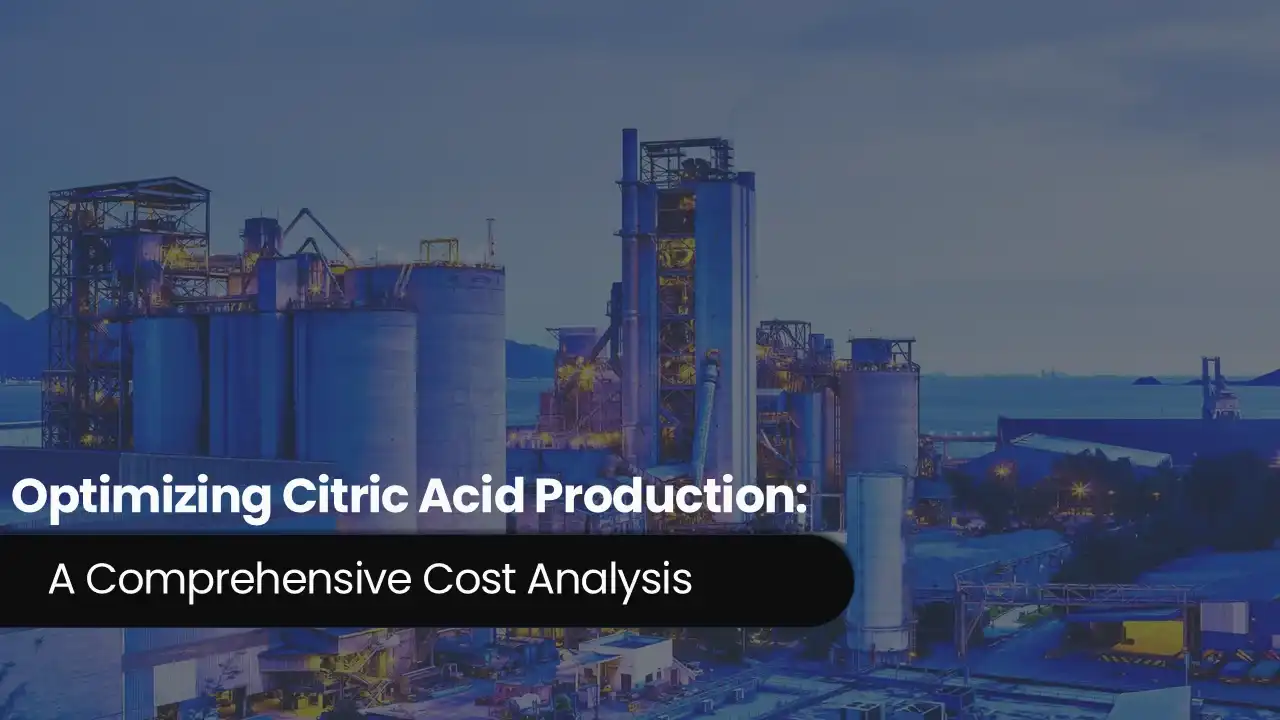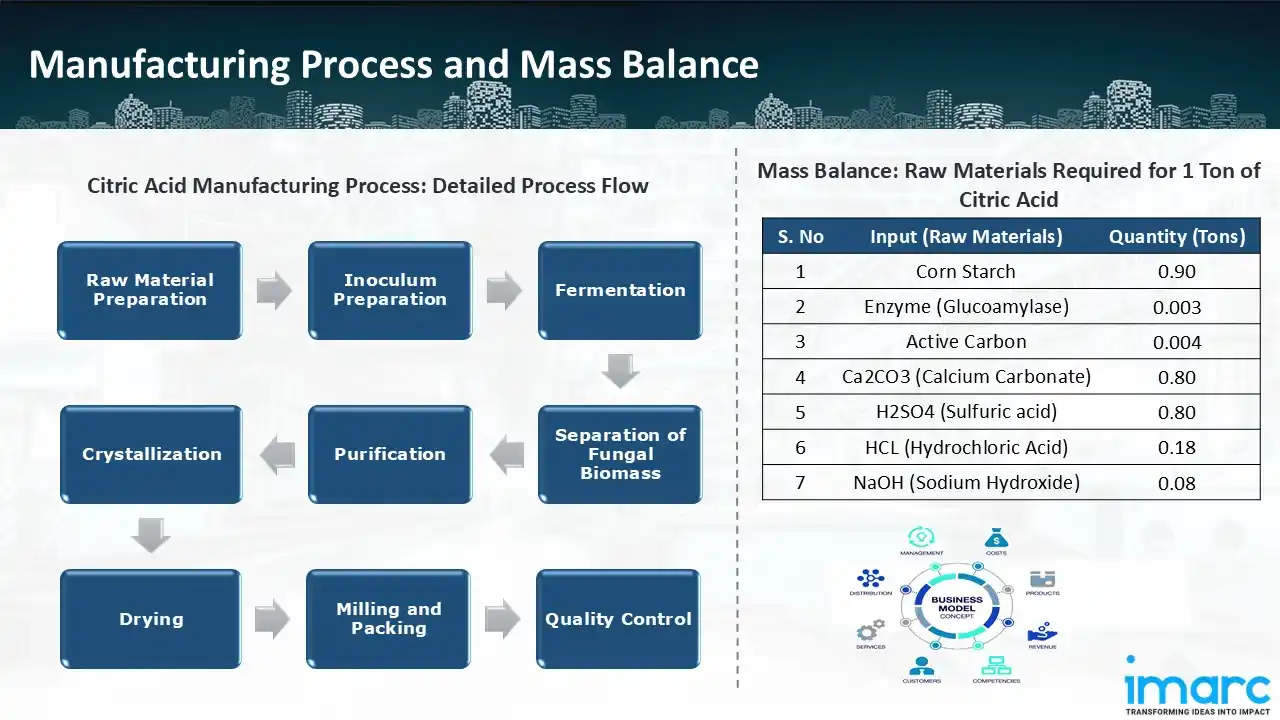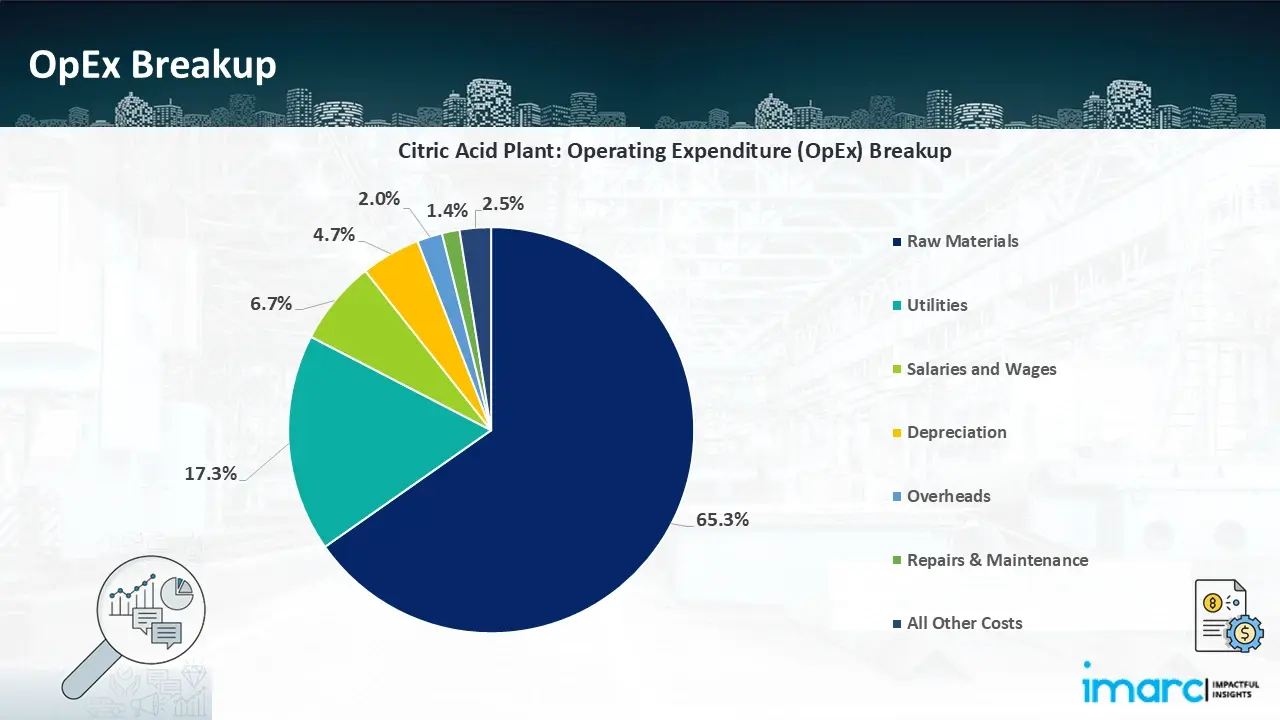Optimizing Citric Acid Production: A Comprehensive Cost Analysis

What is Citric Acid?
Citric acid is a naturally occurring weak organic acid found in citrus fruits, widely used for its sour taste, preservative properties, and acidity regulation.
Key Applications Across Industries:
Industrially, it is produced through the fermentation of sugars and is a key ingredient in the food and beverage industry, where it enhances flavor and preserves freshness. Additionally, it has applications in pharmaceuticals, cosmetics, and cleaning products due to its ability to stabilize ingredients and chelate metals.
What the Expert Says: Market Overview & Growth Drivers
According to an IMARC study, the global citric acid production market was 3.10 Million Tons in 2024, growing at a CAGR of 7.8% from 2019 to 2024. Looking ahead, the market is expected to grow at a CAGR of approximately 5.4% from 2025 to 2033, reaching a projected volume of 4.18 Million Tons by 2033.
The growing demand for citric acid is driven by its versatile applications across various industries. In the food and beverage sector, it is widely used as a preservative and flavor enhancer, aligning with the increasing preference for natural additives. In pharmaceuticals, citric acid plays a critical role due to its antioxidant properties and ability to stabilize medications. The rise of eco-friendly cleaning products has also boosted its use as a safe, biodegradable alternative in household and industrial cleaners. Additionally, the expanding cosmetics industry uses citric acid in personal care products for pH regulation and exfoliation. Increasing health consciousness and a shift towards natural ingredients continue to fuel this demand.
Case Study on Cost Model of Citric Acid Manufacturing Plant:
Objective
One of our clients has approached us to conduct a feasibility study for establishing a mid to large-scale citric acid manufacturing plant in KEZAD Free Zone, Abu Dhabi (UAE).
IMARC Approach: Comprehensive Financial Feasibility
We have developed a comprehensive financial model for the plant's setup and operations. The proposed facility is designed with an annual production capacity of 40,000 tons of citric acid.
Manufacturing Process: Citric acid is produced by fermentation, usually with the aid of Aspergillus niger and carbohydrates such as glucose, molasses, or starch hydrolysates. The feedstock is first sterilised, diluted, then nutrient supplemented. The fungal strain is scaled up for fermentation by inoculum preparation. In fermenters, the sterile feedstock is inoculated under controlled aerobic conditions. The pH and temperature are adjusted to maximise the generation of citric acid over a period of 5–10 days. Filtration or centrifugation are used to remove the fungal biomass from the broth following fermentation. After treating the citric acid-rich filtrate with lime, calcium citrate is precipitated. This calcium citrate then reacts with sulphuric acid to regenerate citric acid, with gypsum as a byproduct. Evaporation concentrates the citric acid solution, and cooling causes it to crystallise. The crystals undergo separation, drying, milling, and packaging to avoid contamination or moisture absorption. Throughout, quality control procedures are used to guarantee product purity and adherence to requirements. By using or disposing of by-products like gypsum and fungal biomass properly, the process is both environmentally sustainable and resource efficient.

Get a Tailored Feasibility Report for Your Project Request Sample
Mass Balance and Raw Material Required: The primary raw materials utilized in the citric acid manufacturing plant include corn starch, enzyme, active carbon, calcium carbonate, sulfuric acid, hydrochloric acid, and sodium hydroxide. To produce 1 ton of citric acid, we require corn starch (0.9 ton), enzyme (glucoamylase) (0.003 ton), active carbon (0.0035 ton), calcium carbonate (0.8 ton), sulfuric acid (0.8 ton), hydrochloric acid (0.18 ton) and sodium hydroxide (0.08 ton).
Techno-Commercial Parameter:
- Capital Investment (CapEx): Capital expenditure (CapEx) in a manufacturing plant includes various investments essential for its setup and long-term operations. It covers machinery and equipment costs, including procurement, installation, and commissioning. Civil works expenses involve land development, factory construction, and infrastructure setup. Utilities such as power, water supply, and HVAC systems are also significant. Additionally, material handling systems, automation, environmental compliance, and safety measures are key components. Other expenditures include IT infrastructure, security systems, and office essentials, ensuring operational efficiency and business growth.
- Operating Expenditure (OpEx): Operating expenditure is the cost incurred to operate a manufacturing plant effectively. OpEx in a manufacturing plant typically includes the cost of raw materials, utilities, depreciation, taxes, packing cost, transportation cost, and repairs and maintenance. The operating expenses are part of the cost structure of a manufacturing plant and have a significant effect on profitability and efficiency. Effective control of these costs is necessary for maintaining competitiveness and growth.

- Profitability Analysis Year on Year Basis: The proposed citric acid plant, with a capacity of 40,000 tons per annum, achieved an impressive revenue of US$ 34.91 million in its first year. We assisted our client in developing a detailed cost model, which projects steady growth, with revenue rising throughout the projected period. Moreover, gross profit improved from 18.83% to 20.73%, and net profit rise from 11.50% to 16.50%, highlighting strong financial viability and operational efficiency.

Conclusion & IMARC's Impact:
Our financial model for the citric acid manufacturing plant was meticulously designed to meet the client’s objectives. It provided a thorough analysis of production costs, including raw materials, manufacturing processes, capital expenditure, and operational expenses. Tailored to the specific requirement of producing 40,000 tons of citric acid annually, the model highlights key cost drivers and forecasts profitability, considering market trends, inflation, and potential fluctuations in raw material prices. This comprehensive financial model offers the client valuable insights for strategic decision-making, demonstrating our commitment to delivering precise, client-focused solutions that ensure the long-term success of large-scale manufacturing projects.
Latest News and Developments:
- In October 2024, Aditxt, a social innovation platform dedicated to health innovations, achieved a major milestone in the amended merger agreement with Evofem Biosciences, with the completion of its last equity investment. Aditxt's attempts to expand its product line into immunotherapy and women's health products have advanced significantly with this development. It is expected that the combination will lead to innovation and growth for both companies.
- In April 2024, it was announced that Russia will open two new citric acid production facilities in 2025. The two will be situated in the Voronezh Region and the Tula Region, respectively.
Why Choose IMARC:
IMARC's Financial Model Expertise: Helping Our Clients Explore Industry Economics
IMARC is a global market research company that offers a wide range of services, including market entry and expansion, market entry and opportunity assessment, competitive intelligence and benchmarking, procurement research, pricing and cost research, regulatory approvals and licensing, factory setup, factory auditing, company incorporation, incubation services, recruitment services, and marketing and sales.
Brief List of Our Services: Market Entry and Expansion
- Market Entry and Opportunity Assessment
- Competitive Intelligence and Benchmarking
- Procurement Research
- Pricing and Cost Research
- Sourcing
- Distribution Partner Identification
- Contract Manufacturer Identification
- Regulatory Approvals, and Licensing
- Factory Setup
- Factory Auditing
- Company Incorporation
- Incubation Services
- Recruitment Services
- Marketing and Sales
Under our factory setup services, we assist our clients in exploring the feasibility of their plants by providing comprehensive financial modeling. Additionally, we offer end-to-end consultation for setting up a plant in India or abroad. Our financial modeling includes an analysis of capital expenditure (CapEx) required to establish the manufacturing facility, covering costs such as land acquisition, building infrastructure, purchasing high-tech production equipment, and installation. Furthermore, the layout and design of the factory significantly influence operational efficiency, energy consumption, and labor productivity, all of which impact long-term operational expenditure (OpEx). So, every parameter is covered in the analysis.
At IMARC, we leverage our comprehensive market research expertise to support companies in every aspect of their business journey, from market entry and expansion to operational efficiency and innovation. By integrating our factory setup services with our deep knowledge of industry dynamics, we empower our clients to not only establish manufacturing facilities but also strategically position themselves in highly competitive markets. Our financial modeling and end-to-end consultation services ensure that clients can explore the feasibility of their plant setups while also gaining insights into competitors' strategies, technological advancements, and regulatory landscapes. This holistic approach enables our clients to make informed decisions, optimize their operations, and align with sustainable practices, ultimately driving long-term success and growth.
Our Clients
Contact Us
Have a question or need assistance?
Please complete the form with your inquiry or reach out to us at
Phone Number
+91-120-433-0800+1-201-971-6302
+44-753-714-6104











